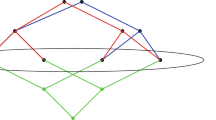Abstract
We show that the problem of constructing a perfect matching in a graph is in the complexity class Random NC; i.e., the problem is solvable in polylog time by a randomized parallel algorithm using a polynomial-bounded number of processors. We also show that several related problems lie in Random NC. These include:
-
(i)
Constructing a perfect matching of maximum weight in a graph whose edge weights are given in unary notation;
-
(ii)
Constructing a maximum-cardinality matching;
-
(iii)
Constructing a matching covering a set of vertices of maximum weight in a graph whose vertex weights are given in binary;
-
(iv)
Constructing a maximums-t flow in a directed graph whose edge weights are given in unary.
Similar content being viewed by others
References
D. Angluin andL. G. Valiant, Fast probabilistic algorithms for Hamiltonian circuits and matchings.J. of Comp. Syst. Sci. 18 (1979), 155–193.
A. Borodin, S. A. Cook andN. Pippenger, Parallel computation for well-endowed rings and space bounded probabilistic machines.Information and Control 58 (1983), 113–136.
A. Borodin, J. von zur Gathen andJ. Hopcroft, Fast parallel matrix and GCD computations.Proc. 23 STOC (1982), 65–71.
S. A. Cook, An overview of computation complexity.CACM 26 (1983), 400–408.
J. Edmonds, Systems of distinct representatives and linear algebra.J. of Res. Nat. Bureau of Standards,71 A (1967), 241–245.
J. Edmonds andR. M. Karp, Theoretical improvements in algorithmic efficiency for network flow problems.J. of ACM 19 (1972), 248–264.
L. M. Goldschlager, R. A. Shaw andJ. Staples, The maximum flow problem is logspace complete for P.Theoretical Computer Science 21 (1982), 105–111.
H. J. Karloff, A Las Vegas RNC algorithm for maximum matchingCombinatorica, to appear.
R. M. Karp, E. Upfal andA. Wigderson, Are search and decision problems computationally equivalent?STOC 1985.
D. Kozen, U. V. Vazirani andV. V. Vazirani, The two-processors scheduling problem is in R-NC.STOC 1985.
L. Lovász, Determinants, matchings and random algorithms,in: Fundamentals of Computation Theory, FCT’79. (ed. L. Budach), Akademie-Verlag Berlin 1979, pp 565–574.
M. O. Rabin andV. V. Vazirani, Maximum matchings in general graphs through randomization, TR-15-84,Harvard University Center for Research in Computing Technology, 1984.
J. T. Schwartz, Fast probabilistic algorithms for verification of polynomial identities.J. of ACM,27 (1980), 701–717.
E. Shamir andE. Upfal,N-processors graphs distributively achieve perfect matching inO(log2 N) beats.Proceeding of the First ACM SIGACT-SIGMOD Symp. on Principles of Distributed Computing. Ottawa, 1982, 238–241.
W. T. Tutte, The factors of graphs.Canad. J. Math. 4 (1952), 314–328.
D. J. A. Welsh,Matroid Theory. Academic Press (1976).
Author information
Authors and Affiliations
Additional information
Research supported by NSF Grant # DCR-8411954.
Research supported by a Weizmann Post-Doctoral fellowship, and by DARPA Grant N00039-83-C-1036.
Rights and permissions
About this article
Cite this article
Karp, R.M., Upfal, E. & Wigderson, A. Constructing a perfect matching is in random NC. Combinatorica 6, 35–48 (1986). https://doi.org/10.1007/BF02579407
Received:
Issue Date:
DOI: https://doi.org/10.1007/BF02579407




